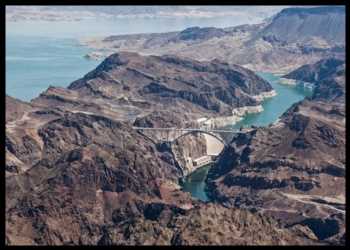7 Basin States Agree On Consensus To Protect Colorado River Basin
The Department of the Interior and seven Colorado River Basin states have reached an agreement on a consensus-based approach that marks an important step to protect the stability of the Colorado River System in the face of climate change and historic drought conditions.
As part of the Department’s continued efforts to address ongoing severe drought conditions and a changing climate in the Colorado River Basin, representatives from the seven Colorado River Basin states have agreed to the submission of a Lower Basin, consensus-based system conservation proposal. They are requesting the proposal be fully analyzed as an action alternative under the Bureau of Reclamation’s draft Supplemental Environmental Impact Statement (SEIS), published last month.
California, Arizona, Nevada, Wyoming, Colorado, Utah and New Mexico are the Colorado River Basin states, which depend on the river for their survival.
The consensus-based proposal agreed upon by the three Lower Basin states – California, Arizona and Nevada – commits to measures to conserve at least 3 million-acre-feet (maf) of system water through the end of 2026, when the current operating guidelines are set to expire. Of those system conservation savings, 2.3 maf will be compensated through funding from the historic Inflation Reduction Act, which is supporting efforts to increase near-term water conservation, build long term system efficiency, and prevent the Colorado River System’s reservoirs from falling to critically low elevations that would threaten water deliveries and power production. Under this consensus proposal, the remaining system conservation needed for sustainable operation will be achieved through voluntary, uncompensated reductions by the Lower Basin states.
“There are 40 million people, seven states, and 30 Tribal Nations who rely on the Colorado River Basin for basic services such as drinking water and electricity. Today’s announcement is a testament to the Biden-Harris administration’s commitment to working with states, Tribes and communities throughout the West to find consensus solutions in the face of climate change and sustained drought,” said Secretary Deb Haaland.
In light of the Lower Basin states’ conservation proposal, the Department of the Interior announced that it is?temporarily?withdrawing?the draft SEIS published last month so that it can?fully analyze the effects of the proposal under the National Environmental Policy Act (NEPA). Reclamation will then publish an updated draft SEIS for public comment with the consensus-based proposal as an action alternative. Accordingly, the original May 30 deadline for the submission of comments on the draft SEIS is no longer in effect.
The Department? said it plans to ?finalize the SEIS process later this year.
Early next month, the Department will formally advance the process for the development of new operating guidelines replacing the 2007 Colorado River Interim Guidelines for Lower Basin Shortages and the Coordinated Operations for Lake Powell and Lake Mead at the end of 2026. In the coming weeks, Reclamation will publish the Notice of Intent for the Environmental Impact Statement related to the post-2026 guidelines.
“Thanks to my Investing in America agenda, we are deploying record resources to support water conservation and improve the Colorado River’s long-term sustainability,” President Joe Biden said in a statement on the historic agreement. “This approach will benefit the 40 million people who rely on the Colorado River Basin for agriculture, drinking water, and power, and is a critical step to building a sustainable, resilient future for states, Tribes and communities throughout the West,” he added.
Source: Read Full Article


